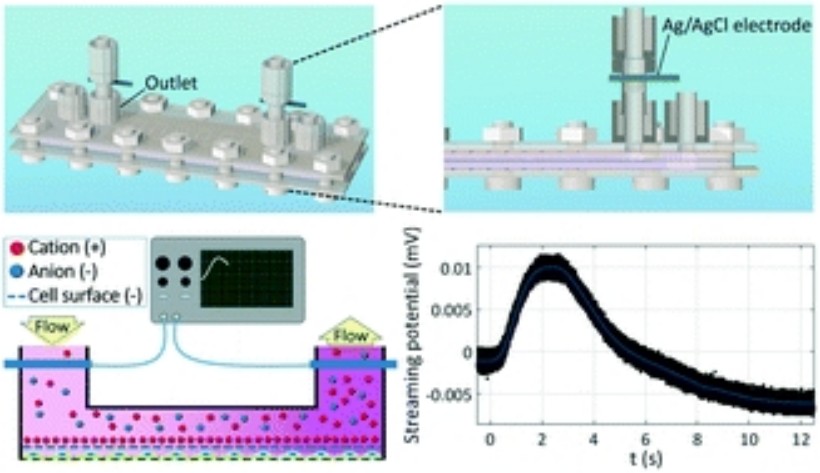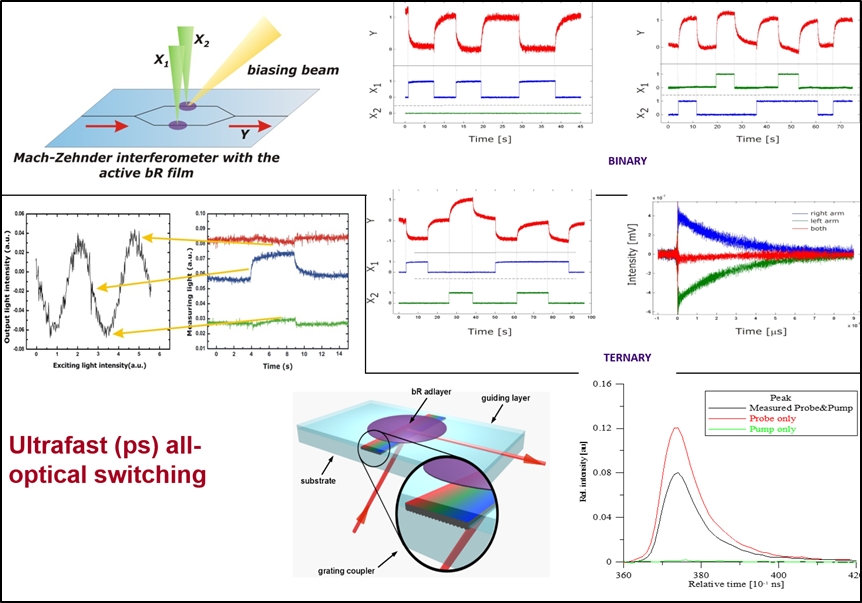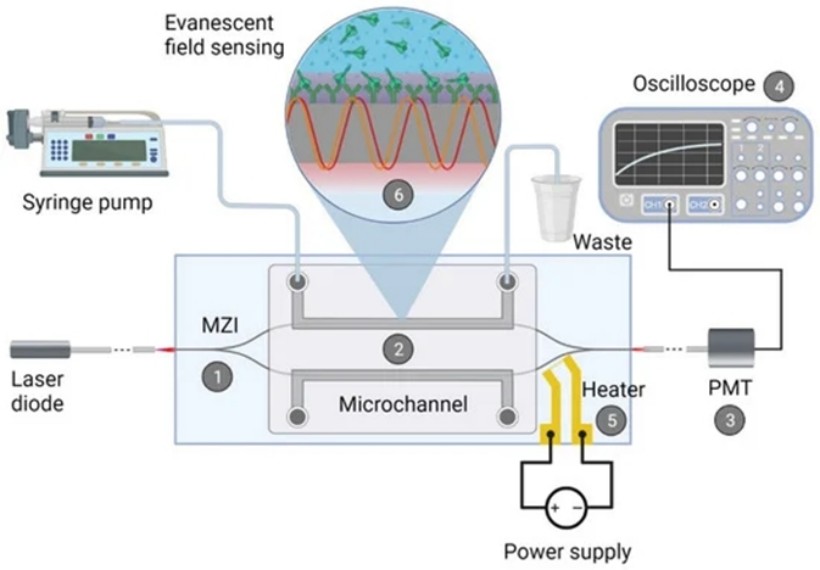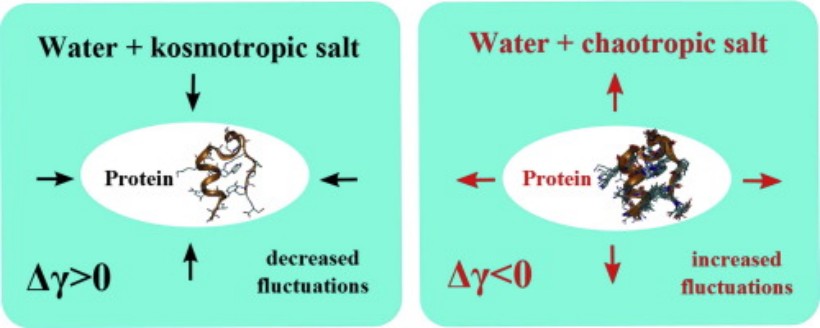
Bioelectronics has a double meaning in scientific literature. On the one hand, as a branch of basic biophysical sciences, it deals with electric phenomena appearing on any organization level of living systems (A). On the other hand, as a recently developed discipline of information technological science, it is exploring chances of biological materials for application in molecular electronics (B). Important objects in both disciplines are the biological interfaces separating structural units. Our main goal is to develop novel methods on integrated micro- and nanotechnological platforms for the investigation of electric and optical phenomena at bio-interfaces, and utilize them in both branches of bioelectronic science. Besides its impact on basic biophysical science, this research is expected to have applications in various branches of molecular electronics.
Recently, we have started developing such lab-on-a-chip model systems that enable the complex biophysical characterization of biological interfaces separating adjacent organs, including the investigation of the electric impedance, transport properties, or zeta-potential of the cell layers, under continuous circulation conditions and visual monitoring (by a microscope). We carry out these activities as a joint research effort by the Biological Barriers group of the Neurobiology Unit, lead by Prof. Maria Deli. [1, 5, 8, 9, 11].

A chip device to measure the surface charge properties of confluent cell monolayers
Not only physics can help solving biological problems, but biology may also facilitate (applied) physics research. Our experimental results demonstrated the applicability special protein films as an active, programmable nonlinear optical elements of all-optical integrated circuits [2, 3, 6]. Based on these findings, a USA patent [Light-driven integrated optical device (US 6,956,984 B2)] have been registered.

Integrated optical logic and photonic switching by biofilms
Recently, we have developed such an integrated optical biosensor, whose sensing element (a Mach_Zehnder interferometer) can be optically fine-tuned for optimal performance, via illuminating a thin protein film. Having performed successful test experiments with the device, we are working on the adaptation of the method to rapid sensing of proteins or bacteria from body fluids [4, 7].

Label-free, integrated optical biosensor device
Our long-term goal is to utilize the results of our research carried out in both branches of bioelectronics, in practical applications in e.g., optoelectronics, pharmaceutic research or medical diagnostics.
Novel theoretical concepts and related model calculations are also expected to facilitate a thorough understanding of the function of biological interfaces. A large set of experimental evidences supporting the tight connection between the structure of interfacial water and the biological function of the barrier layer have been piled up during the recent decades. In this spirit, we are performing molecular dynamics calculations to describe the interaction of biological macromolecules and water [10, 12]. The results of our simulations can serve as a basis of the rational design of new and effective peptide-based drugs, as well.

Interfacial water structure determines protein conformation
Kincses, András ; Vigh, Judit P. ; Petrovszki, Dániel ; Valkai, Sándor ; Kocsis, Anna E. ; Walter, Fruzsina R. ; Lin, Hung-Yin ; Jan, Jeng-Shiung ; Deli, Mária A.; Dér, András: The Use of Sensors in Blood-Brain Barrier-on-a-Chip Devices: Current Practice and Future Directions. BIOSENSORS 13 : 3 p. 357 (2023)
Krekic, Szilvia ; Mero, Mark ; Dér, András; Heiner, Zsuzsanna: Ultrafast All-Optical Switching Using Doped Chromoprotein Films. JOURNAL OF PHYSICAL CHEMISTRY C 127: 3 pp. 1499-1506. , 8 p. (2023)
Petrovszki, Dániel ; Valkai, Sándor; Kelemen, Lóránd; Nagy, László; Agarwal, Vivechana; Krekic, Szilvia ; Zimányi, László; Dér, András: Microsecond All-Optical Modulation by Biofunctionalized Porous Silicon Microcavity. NANOMATERIALS 13 : 14 p. 2070 (2023)
Petrovszki, Dániel ; Walter, Fruzsina R. ; Vigh, Judit P. ; Kocsis, Anna ; Valkai, Sándor ; Deli, Mária A ; Dér, András: Penetration of the SARS-CoV-2 Spike Protein across the Blood–Brain Barrier, as Revealed by a Combination of a Human Cell Culture Model System and Optical Biosensing. BIOMEDICINES 10 : 1 Paper: 188 (2022)
Buchroithner, B. ; Mayr, S. ; Hauser, F. ; Priglinger, E. ; Stangl, H. ; Santa-Maria, A.R. ; Deli, M.A. ; Der, A. ; Klar, T.A. ; Axmann, M. et al.: Dual Channel Microfluidics for Mimicking the Blood-Brain Barrier. ACS NANO 15 : 2 pp. 2984-2993. , 10 p. (2021)
Petrovszki, Daniel ; Krekic, Szilvia* ; Valkai, Sandor ; Heiner, Zsuzsanna ; Der, Andras: All-Optical Switching Demonstrated with Photoactive Yellow Protein Films. BIOSENSORS 11: 11 Paper: 432 , 11 p. (2021)
Petrovszki, Dániel ; Valkai, Sándor ; Gora, Evelin ; Tanner, Martin ; Bányai, Anita ; Fürjes, Péter ; Dér, András: An integrated electro-optical biosensor system for rapid, low-cost detection of bacteria. MICROELECTRONIC ENGINEERING 239 Paper: 111523 , 9 p. (2021)
Vigh, Judit P. ; Kincses, András* ; Ozgür, Burak ; Walter, Fruzsina R. ; Santa-Maria, Ana Raquel ; Valkai, Sándor ; Vastag, Mónika ; Neuhaus, Winfried ; Brodin, Birger ; Dér, András et al.: Transendothelial Electrical Resistance Measurement across the Blood–Brain Barrier: A Critical Review of Methods. MICROMACHINES 12 : 6 Paper: 685 , 18 p. (2021)
Kincses, András ; Santa-Maria, Ana R ; Walter, Fruzsina R ; Dér, László ; Horányi, Nóra ; Lipka, Dóra V ; Valkai, Sándor ; Deli, Mária A ; Dér, András: A chip device to determine surface charge properties of confluent cell monolayers by measuring streaming potential. LAB ON A CHIP 20 : 20 pp. 3792-3805. , 14 p. (2020)
Násztor, Zoltán ; Bogár, Ferenc ; Dér, András: The interfacial tension concept, as revealed by fluctuations. CURRENT OPINION IN COLLOID & INTERFACE SCIENCE 23 pp. 29-40. , 12 p. (2016)
Walter, FR ; Valkai, S ; Kincses, A ; Petneházi, A ; Czeller, T ; Veszelka, S ; Ormos, P ; Deli, MA ; Dér, A: A versatile lab-on-a-chip tool for modeling biological barriers. SENSORS AND ACTUATORS B-CHEMICAL 222 pp. 1209-1219. , 11 p. (2016)
Bogar, Ferenc ; Bartha, Ferenc ; Nasztor, Zoltan ; Fabian, Laszlo ; Leitgeb, Balazs ; Der, Andras: On the Hofmeister Effect: Fluctuations at the Protein-Water Interface and the Surface Tension. JOURNAL OF PHYSICAL CHEMISTRY B 118 : 29 pp. 8496-8504. , 9 p. (2014)

scientific adviser

research fellow

research fellow

research fellow

PhD student
 András DÉR
András DÉR
|
scientific adviser | publications | CV |
 Sándor VALKAI
Sándor VALKAI
|
research fellow | publications | CV |
 Zoltán NÁSZTOR
Zoltán NÁSZTOR
|
research fellow | publications | CV |
 Balázs LEITGEB
Balázs LEITGEB
|
research fellow | publications | CV |
 János HORVÁTH
János HORVÁTH
|
PhD student | publications | CV |